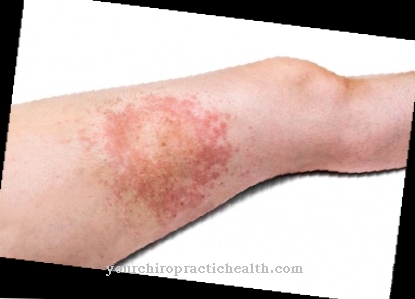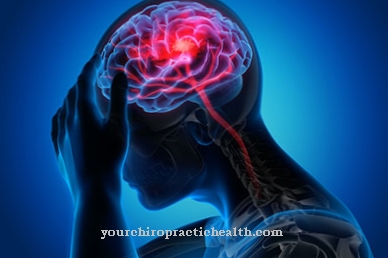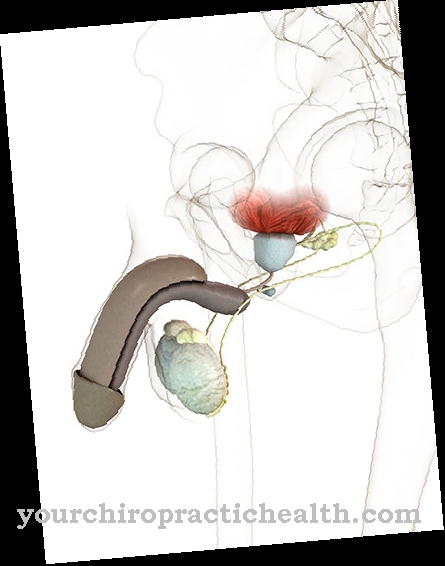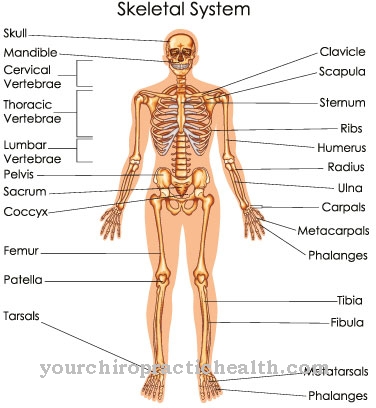A Carotid stenosis is the narrowing of the carotid artery, which supplies the brain with oxygen and nutrients. The disease is caused by debris in the artery. Carotid stenosis is one of the most common causes of stroke.
What is carotid stenosis?
.jpg)
The Carotid stenosis is a narrowing of the carotid artery. Stenosis means "tightness" and carotid stands for carotid artery. This is the artery that runs on both sides of the neck and branches into the internal carotid artery (internal carotid artery) and external carotid artery (external carotid artery).
The inner artery runs to the brain and supplies it with oxygen and nutrients; the outer one is responsible for the care of the face. When one speaks of a carotid stenosis, the internal artery is meant. The constriction is caused by deposits in the vessel, they obstruct the blood flow and thus reduce the blood supply to the brain.
With carotid stenosis, there is always the risk of a stroke, as deposits can loosen, which are then transported to the brain and cause a cerebral infarction there. It is believed that around 60% of all strokes are caused by carotid stenosis.
causes
The cause of the Carotid stenosis is usually the arteriosclerosis (calcification of the vessels). Substances known as arteriosclerotic plaques are deposited in the vessels. They clog the arteries so that blood can no longer flow freely.
Due to the reduced blood flow, too little oxygen and nutrients are transported, which leads to an undersupply of the corresponding organ. If the carotid artery is affected, this leads to an insufficient supply of the brain. The cause of arteriosclerosis, on the other hand, is usually high blood pressure, unhealthy, high-fat foods, little exercise and smoking.
Most commonly, patients with peripheral arterial disease (PAOD) develop carotid stenosis. In this disease, especially the vessels of the extremities, i.e. the arms and legs, calcify. Carotid stenoses also develop in patients with coronary artery disease (CHD), in which the vessels in the heart become calcified, but less frequently in comparison.
Symptoms, ailments & signs
Carotid stenosis is often asymptomatic in the first stage. In the later stages symptoms such as speech disorders, paralysis and nerve disorders in the face and limbs appear. In addition, visual disturbances and dizziness can occur. In the area of vision, there are disturbances such as blurred vision, double vision or visual field deficits in which the patient no longer has any perception in the left or right part of the field of vision.
The visual disturbances last a few seconds to minutes. Furthermore, speech disorders, hearing problems and swallowing difficulties can arise. At the beginning, the symptoms usually only appear briefly and quickly subside. If left untreated, a stroke can occur. A stroke manifests itself as permanent visual, hearing and speech disorders, paralysis and neurological damage.
Those affected can usually only move to a limited extent and suffer from reduced mental performance. Flaccid facial muscles can also be noticed. Depending on the severity of the carotid stenosis, cramps, circulatory disorders and other complications can occur. The carotid stenosis itself occurs suddenly and is over in a few minutes. In mild cases, only imperceptible deficits remain; in severe cases, a stroke can be fatal.
Diagnosis & course
In the initial stage the shows Carotid stenosis mostly no symptoms. Carotid stenosis that goes unnoticed is common, especially in older people. This is referred to as an asymptomatic carotid stenosis or a stenosis in stage I.
Symptoms only appear in stage II, as the artery is now more narrowed. This can lead to visual disturbances, short-term paralysis, dizziness or speech disorders. The symptoms are temporary in stage II, which means that they regress again, usually within 24 hours. If it takes longer than a day for the deficiency symptoms to disappear, one speaks of a "little stroke".
Stage III is a carotid stenosis with a recently diagnosed stroke. Stage IV is what the doctor calls the condition after a past stroke with permanent damage.The suspicion of a diagnosis of carotid stenosis arises from the failure symptoms. However, in this condition the stenosis is already advanced. Deposits in the artery can be made visible using ultrasound.
Today, the special duplex ultrasonography is used for diagnostics, with which the severity of the carotid stenosis can also be recognized. Another examination method is angiography, in which, after a contrast agent has been injected beforehand, the arteries are visualized using X-rays or computer tomography (CT) and the carotid stenosis can be recognized.
Complications
Carotid stenosis can lead to various consequential damages and complications. In most cases, however, this narrowing leads to a stroke, which in the worst case can also be associated with the death of the patient. For this reason, carotid stenosis should definitely be examined and treated by a doctor.
Those affected can primarily suffer from paralysis, which can occur in different regions of the body. Other disorders of sensitivity or sensory disorders can also limit the patient's quality of life. Furthermore, it can lead to shortness of breath and thus to a loss of consciousness. It is not uncommon for severe headaches and speech disorders to occur.
The carotid stenosis also limits and reduces coordination and concentration. The patients can continue to suffer from depression and other Saxon moods or complaints. Carotid stenosis can be treated with surgery and medication.
There are no particular complications. However, life expectancy is reduced in most cases due to carotid stenosis. The sufferer must follow a healthy diet and an overall healthy lifestyle.
When should you go to the doctor?
If you experience visual disturbances, dizziness, speech disorders, or other signs of carotid stenosis, a doctor should be consulted immediately. If the symptoms persist for more than a day, a doctor must be called in. Medical advice is also required if the symptoms increase the risk of an accident or have already led to falls in the past. If a stroke occurs, the emergency doctor must be alerted immediately. The patient then requires extensive treatment in the hospital.
In principle, a carotid stenosis must be clarified as soon as possible. If the narrowing is not treated, a stroke can result. Therefore, a doctor should be consulted at the first signs of illness. Elderly people and stroke patients are particularly prone to developing carotid stenosis and should see a doctor immediately if these symptoms occur. Further medical examinations are necessary if the symptoms do not subside or suddenly increase in intensity. Those affected should contact their family doctor or an internist.
Treatment & Therapy
The treatment or therapy of stroke should be initiated as soon as possible. The longer the brain is without oxygen, the more nerve cells die and the brain can no longer be healed. If a stroke occurs, this must be reported to an emergency doctor immediately.
A Carotid stenosis is usually treated surgically from stage II. Patients with a narrowing that is only in stage I are given drugs to stop platelet formation and to lower blood lipids and blood pressure.
Statins are also administered, which counteract the formation of deposits and thereby slow down the development of arteriosclerosis. Surgical therapy usually consists of a thrombendarterectomy (TEA). In this method, the affected artery is opened lengthways at the narrowed point and the debris is peeled out. This procedure can take place under general anesthesia, but also with local anesthesia.
A variant of the TEA is the eversion TEA, in which the calcified part of the artery is separated out, freed of calcium deposits using a special process and then reinserted. Another possible surgical procedure is carotid angioplasty, in which the constriction is widened by means of an inserted balloon and a stent (vascular support) is inserted, which keeps the artery open. However, this method is not yet routinely used for carotid stenosis; the classic procedure is TEA.
Outlook & forecast
A narrowing of the carotid artery can lead to life-threatening development. In the worst case, the person affected will lose their life in an acute situation. Lifelong physical impairments that lead to a reduction in quality of life are also possible. These are usually irreparable and can lead to psychological complications due to the emotional stress.
If an unhealthy lifestyle is the cause of carotid disease, a change in lifestyle must be made as soon as possible. Otherwise, the prognosis is unfavorable, since without medical care it will lead to the death of the person concerned. The diet must be changed and the consumption of harmful substances such as alcohol or nicotine must be completely avoided.
At an advanced stage of the disease, the affected person needs an operation to increase their chances of survival and prevent a stroke. Treatment carries various risks and can lead to complications.
The way of coping with everyday life has to be changed in the case of carotid disease. The physical resilience is reduced and leads to a restriction in the performance of normal physical work. This leads to a decrease in well-being and can worsen the overall situation. Those affected by a narrowing of the carotid artery are permanently at risk of an outbreak of an acute health situation. If a sudden deterioration occurs, intensive medical care as soon as possible is necessary.
prevention
One can Carotid stenosis prevent by avoiding the risk factors for atherosclerosis. With a healthy, balanced diet, sufficient exercise, alcohol only in moderation and avoiding nicotine, it is possible to effectively prevent carotid stenosis.
Aftercare
Carotid stenosis is a serious condition that definitely needs to be examined and treated by a doctor. In most cases, the follow-up measures are relatively limited, so that the person affected should primarily make a quick diagnosis. A doctor should be contacted as soon as the first signs and symptoms of the disease appear, whereby an early diagnosis usually has a very positive effect on the further course of the disease.
The treatment is carried out by taking various drugs. The correct dosage must always be observed in order to permanently alleviate the symptoms. Likewise, a healthy lifestyle with a healthy diet usually has a very positive effect on the further course of the carotid stenosis, so that the person affected should pay attention to a nutrition plan from a doctor.
If the stenosis of the carotid artery is treated with an operation, the person concerned should rest after such an operation and take care of his body. The life expectancy of the person affected may be reduced by this disease, whereby the further course depends heavily on the time of diagnosis.
You can do that yourself
The measures to be taken in case of carotid stenosis depend on the stage of the disease. Treatment is not always necessary in the first stage. Patients should watch out for any symptoms and see a doctor regularly to make sure there are no complications.
In addition, a change in lifestyle can be useful. Depending on the underlying cause of the symptoms, any excess weight must be reduced, stimulants avoided and / or regular exercise. For hereditary conditions, the most important thing to do is to monitor symptoms. Second-stage carotid stenosis is usually treated surgically. After such an operation, the person concerned first needs rest and protection.
In addition, drugs are prescribed to lower blood pressure and blood lipids. In some cases, natural remedies can be added to the medication. Painkillers and preparations that widen the blood vessels have proven particularly effective. The use of alternative remedies should first be discussed with the doctor. A third stage carotid stenosis must be treated immediately by an emergency doctor. If you have already had a stroke, first aid must be provided until the emergency services arrive.

.jpg)











.jpg)

.jpg)
.jpg)











.jpg)